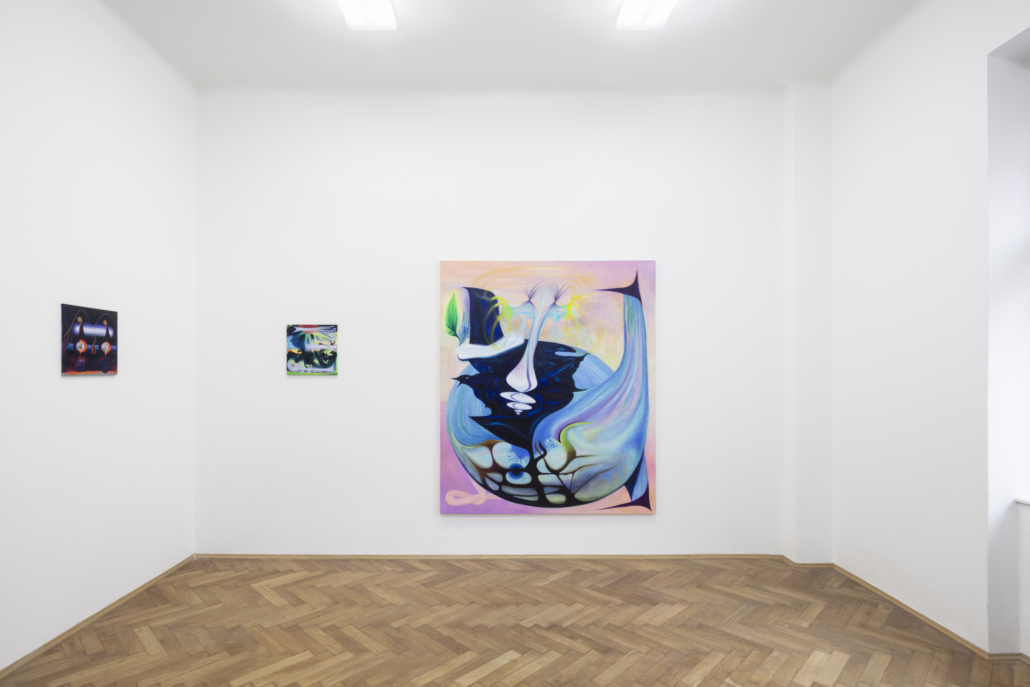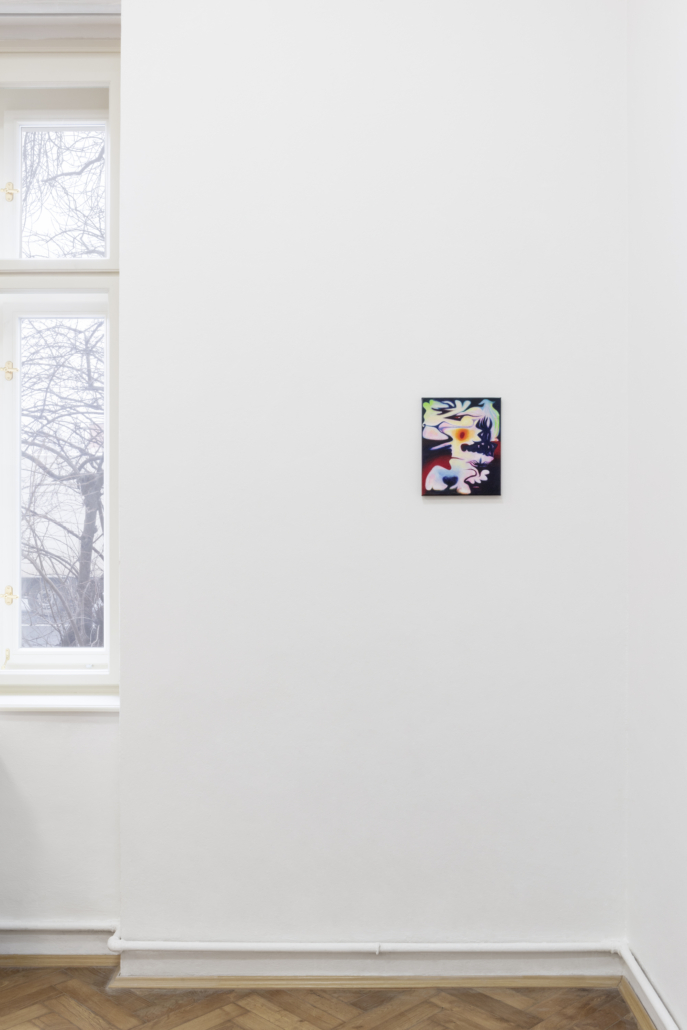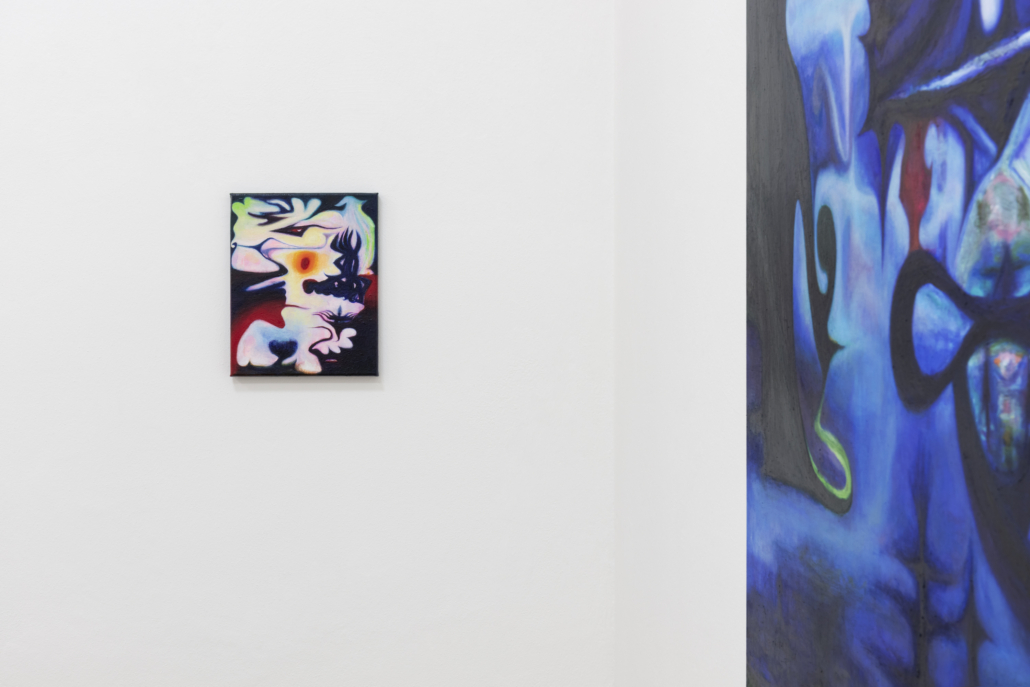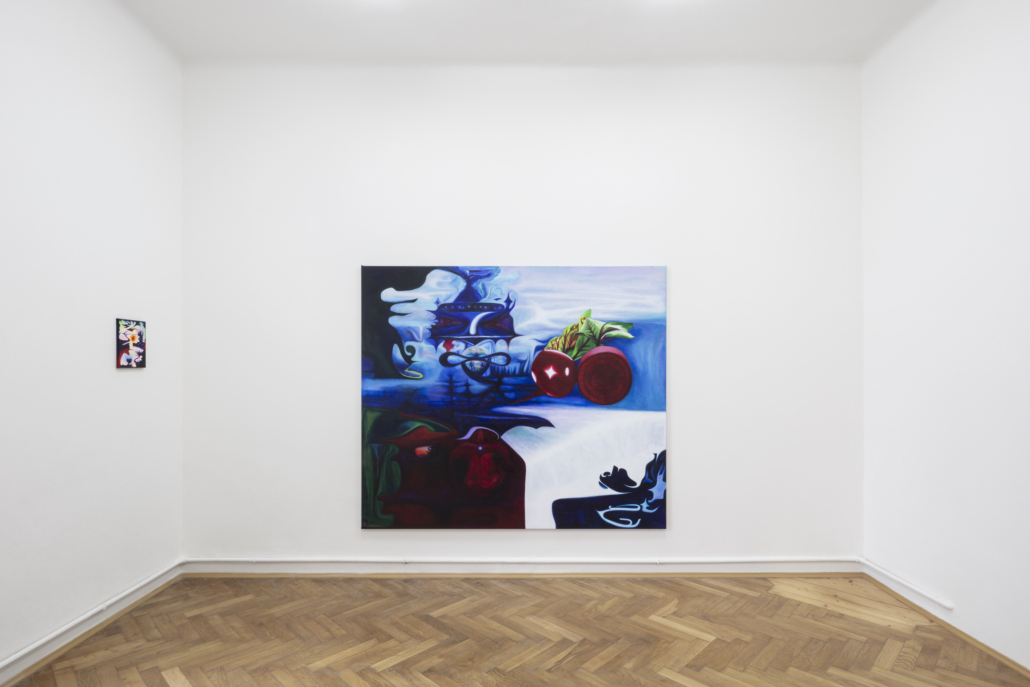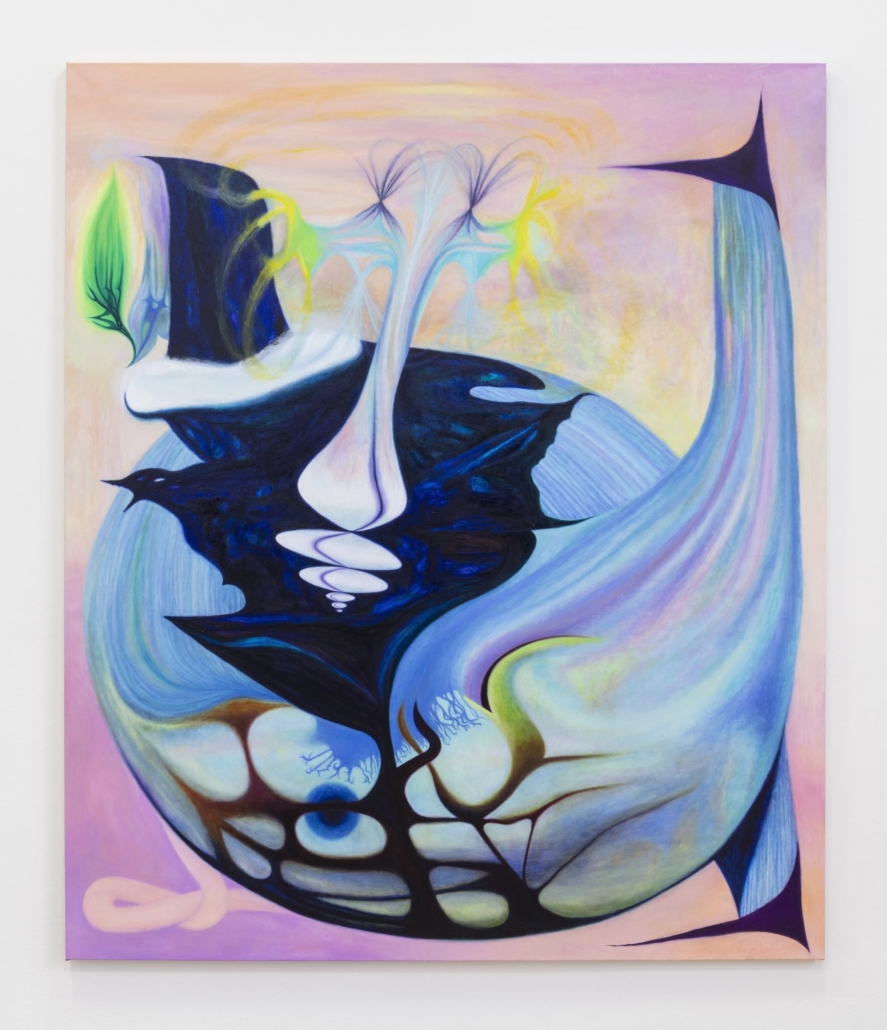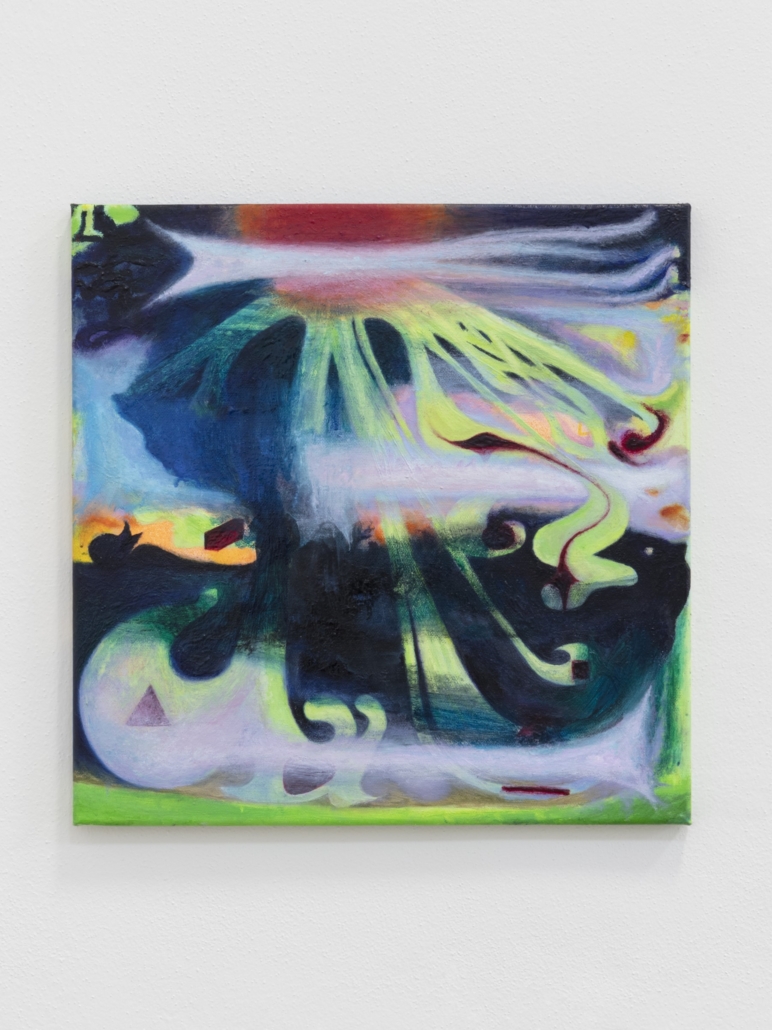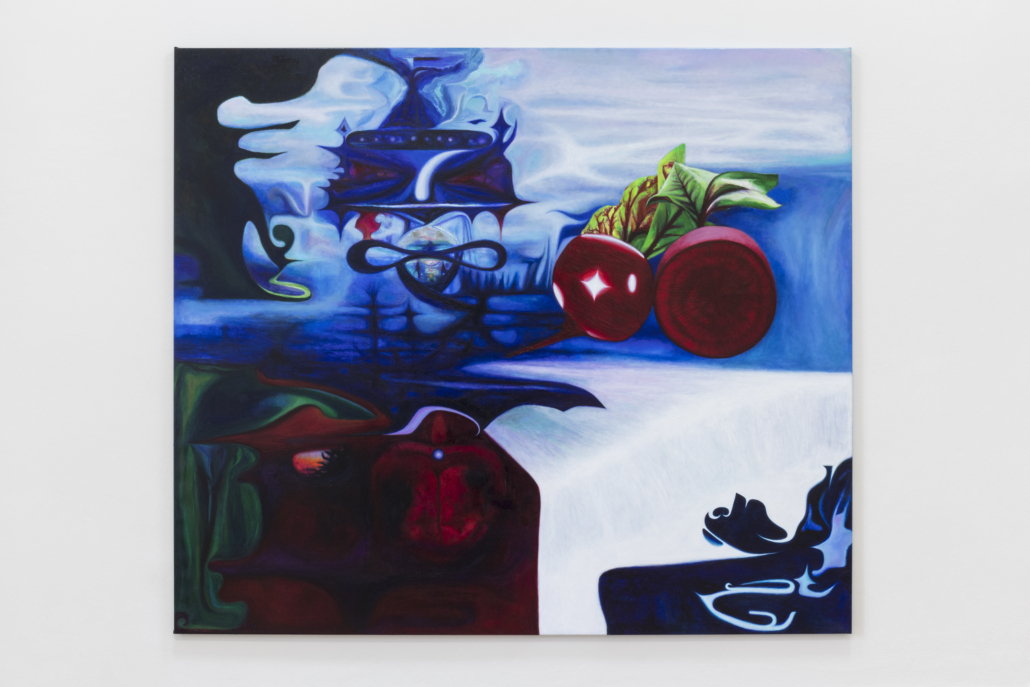VIKTORIE LANGER / PRAXIS
06/02/25–22/03/25
ARTWORKS
TEXT ENG
Just as potatoes are gleaned row by row, I, with my few sentences, glean alongside the paintings and practice of Viktorie Langer.
I have found that once writing begins, various analogies start to multiply. Similar or apt comparisons seemingly appear at every turn.
It is said that our language is full of dead metaphors. The leg of a table, a line of text—these were originally figurative extensions of meaning. Likewise, in visual art, curves or sharp shapes, color transitions, or structural elements were originally something else, usually something concrete. Painting, then, is primarily a fossilized spectacle of neuroplastic processes and the calculated reality of the brain.
It is said that representative art of all kinds (and probably also non-representative art) relies on the understanding that something can stand in for something else and that it can aid thought or communication. Analogies and metaphors form the foundation of the human ability to create symbols.
Thus, the question is: what is being represented? Could it be the Central Bohemian landscape? The wooded groves? Perhaps the plowed fields? A vegetable garden? Earthworms in compost? Or the mist rising from the river? The remnants of conversations hidden in the shade from the heat? Words that speak of transcendence and generalization? Or those that mention language, map-making, target-throwing, and culture as an epidemic?
In paintings, one can move left, right, up, and down—but not forward or backward. The dimension of time is immersed in the subtly vibrating solution of brushstrokes from small and medium-sized brushes, that is, in the present. Emerging on the surface are leaf veins, fungal spores, or the excited Phallus impudicus. The rest of the cosmos—including a single planet, promising dawns, and familiar faces—becomes the food of abstraction. After all, without the ability to abstract, human thought would be something entirely different.
The layers of paint accumulate against convention, especially in the darker areas of the paintings. Perhaps something is trying to break free from the shadows. Or maybe it is simply the physical substance of paint asserting itself over its representational role.
It is known that Primo Levi once said in an interview that a book must function like a telephone leading out of a hall of mirrors. By analogy, Viktorie Langer’s exhibition is a composition built on distance, clarity, ambiguity, transcendence, and persistence.
Marek Meduna
Viktorie Langer in conversation with Habima Fuchs
Habima: When I enter a space where your paintings are displayed, my first three associations are: levels, colors, and mirroring. So I would like to ask about these three aspects of your work. From your paintings, I perceive a connection between different worlds, between levels of existence or, in other words, dimensions. Sometimes they cluster into solid shapes, and at other times they spread out into a space that both connects and separates them. Some of these levels reflect things perceptible through the senses in three-dimensional reality, while others require an additional perspective and an openness to imagination. However, I feel that they coexist in balance. Is your work an expression of thinking about and perceiving the multidimensional reality of the world, or could you share what these compositions stem from and how they come into being?
Viktorie: I perceive multidimensionality more subconsciously rather than as something I actively think about. But it’s interesting to imagine what the transitions between dimensions might look like—how transformation or expansion occurs, or whether the same thing becomes something else, changing along with the observer, if one were present. Or the fact that different dimensions coexist simultaneously in the same place and at the same time, in mutual balance, as you say. I don’t know much about physics, but imagination is closer to me.
Habima: Another aspect is the bright, strong, and sometimes receding colors in your paintings. It is well known that colors have a direct impact on the human organism, especially when they are in their natural state, and their effect can be enhanced by certain shapes. How do you use colors? Is it an intuitive process? Do you follow a system? Is there a specific intention behind your use of color?
Viktorie: I don’t follow any system; my tool is cultivated sensitivity and intuition. I perceive color as an abstract, specific language. For me, expressing myself through colors and shapes is far more precise than verbal or written words, and this message cannot even be fully translated into ordinary speech. My intention is to create a nonverbal experience for the observer, similar to listening to music.
Habima: Some of your paintings contain motifs of mirroring, doubling, and pairing. Human life and the world we create are a constant balancing act of polarities, both within and outside of us. Is this aspect in your work connected to the theme of polarity, or are there other sources of inspiration behind it?
Viktorie: Polarity is omnipresent; it is a fundamental condition of existence itself. It appears in every aspect of life. I started noticing this geometry more in nature and the surrounding world, which led to this motif appearing repeatedly in my work.
TEXT CZ
Podobně jako se brambory paběrkují v jednotlivých řádcích. I já svými nemnoha větami paběrkuji vedle obrazů a praxe Viktorie Langer.
Mám zkušenost, že při započetí psaní se začínají množit nejrůznější analogie. Podobné, či výstižné je zdánlivě možné vidět na každém kroku.
Náš jazyk je prý plný mrtvých metafor. Noha od stolu, řádek textu byl původně přenášením významu. Také u výtvarného umění byly obliny či ostré tvary, barevné přechody nebo části struktur původně něčím jiným a většinou konkrétním. Malba je tak především zkamenělou podívanou na neuroplastické procesy a kalkulovanou realitu mozku.
Říká se, že reprezentativní umění všeho druhu (a pravděpodobně také nereprezentativní umění) závisí na pochopení, že něco může zastupovat něco jiného a že může pomoci myšlení nebo komunikaci. Analogie nebo metafory, které jsou základem lidské schopnosti vytvářet symboly.
Tudíž otázkou je, co je tím zastupovaným něčím? Může to být krajina středních Čech. Remízky. Snad rozoraná pole. Zeleninová zahrada. Žížaly v kompostu. Nebo mlha stoupající od řeky. Zbytky hovorů ukryté ve stínu před vedrem. Slova, která mluví o přesahu a zobecnění. Nebo ta, která zmiňují jazyk, kreslení map, házení na cíl a kulturu jako epidemii.
V obrazech se lze pohybovat doleva, doprava, nahoru, dolů, nikoliv však dopředu a vzadu. Dimenze času je ponořena do jemně vibrujícího nálevu rukopisu menších a středních štětců, tedy do přítomnosti. Na hladině se vynořuje tu žilnatina listů, houbové spory či vzrušený Phallus impudicus. Zbytek kosmu, včetně jedné planety, nadějných úsvitů a povědomých tváří, se stává potravou abstrakce. Ostatně bez schopnosti abstrahovat by lidské myšlení bylo něčím zcela odlišným.
Nánosy barev jsou nahromaděny oproti konvenci především v tmavších částech obrazů, možná se ze stínů cosi pokouší prodrat ven. Ale třeba jen fyzická matérie barvy získává navrch nad její zastupitelskou rolí.
Je známo, že Primo Levi v jednom ze svých četných rozhovorů pravil, že kniha musí fungovat jako telefon vedoucí ven ze zrcadlové bludiště. Analogicky je výstava Viktorie Valocké skladbou budovanou z odstupu, zřetelnosti, nejasnosti, přesahu i umanutosti.
Marek Meduna
Rozhovor Habimy Fuchs s Viktorií Langer
Habima: Když vejdu do prostoru, ve kterém visí Tvé obrazy, jsou moje první tři asociace: úrovně, barvy a zrcadlení. Ráda bych se tedy zeptala na tyto tři aspekty ve Tvé tvorbě. Z obrazů vnímám propojenost mezi různými světy, mezi úrovněmi bytí nebo jiným slovem dimenzemi, které se někdy shlukují do pevných tvarů a jindy se rozprostřou v prostoru, který je spojuje i odděluje. Některé z úrovní jsou odrazem věcí vnímatelných smyslově ve třídimenzionální realitě a jiné potřebují zapojit i další pohled a otevřít pole imaginace. Mám ale pocit, že koexistují spolu ve vyrovnanosti. Je tvá tvorba výrazem přemýšlení a vnímání multidimenzionální reality světa, nebo mohla by ses podělit o to, z čeho taková kompozice vychází, jak vzniká?
Viktorie: Multidimenzionalitu vnímám spíš podvědomě, než že bych o ní přemýšlela. Je to ale zajímavé, představit si, jak asi vypadají přechody mezi dimenzemi, jak probíhá přeměna, rozšíření, nebo jestli ta stejná věc se stává jinou, a mění se také pozorovatel, kdyby tam byl. Nebo ten fakt, že různé dimenze koexistují zároveň na stejném místě a ve stejnou dobu, ve vzájemné vyrovnanosti jak říkáš. Moc toho o fyzice nevím, bližší je mi imaginace.
H: Dalším aspektem jsou jasné, silné někdy i ustupující barvy v tvých malbách. Je známo, že barvy přímo působí na organismus člověka, hlavně pokud jsou v přirozeném stavu a posilujícím prvkem může být i kombinace s určitými tvary. Jak používáš barvy ty? Je to intuitivní proces? Využíváš nějaký systém? Je v používání barev nějaký konkrétní záměr?
V: Nepoužívám žádný systém, mým prostředkem je pěstovaná citlivost a intuice. Barvu vnímám jako abstraktní specifickou řeč nebo jazyk. Pro mě je vyjadřování pomocí barvy a tvarů mnohem přesnější než verbální nebo psaná slova, a do běžné řeči se to sdělení nedá ani přenést. Záměrem je nonverbální prožitek pro pozorující*ho, podobně jako například poslech hudby.
H: Některé obrazy v sobě mají motiv zrcadlení, zdvojení, párovosti. Lidský život a svět, který člověk tvoří jsou neustálým balancováním polarit, jak uvnitř tak i venku. Je tento aspekt v tvé tvorbě spojen s tématem polarity nebo jsou zde další motivy z kterých vychází?
V: Je to všudypřítomná polarita, která je podmínkou samotné existence. Objevuje se v každém aspektu života. Začala jsem si této geometrie všímat více v přírodě a okolním světě, a to vedlo k tomu, že se tento motiv začal objevovat opakovaně i v tvorbě.
